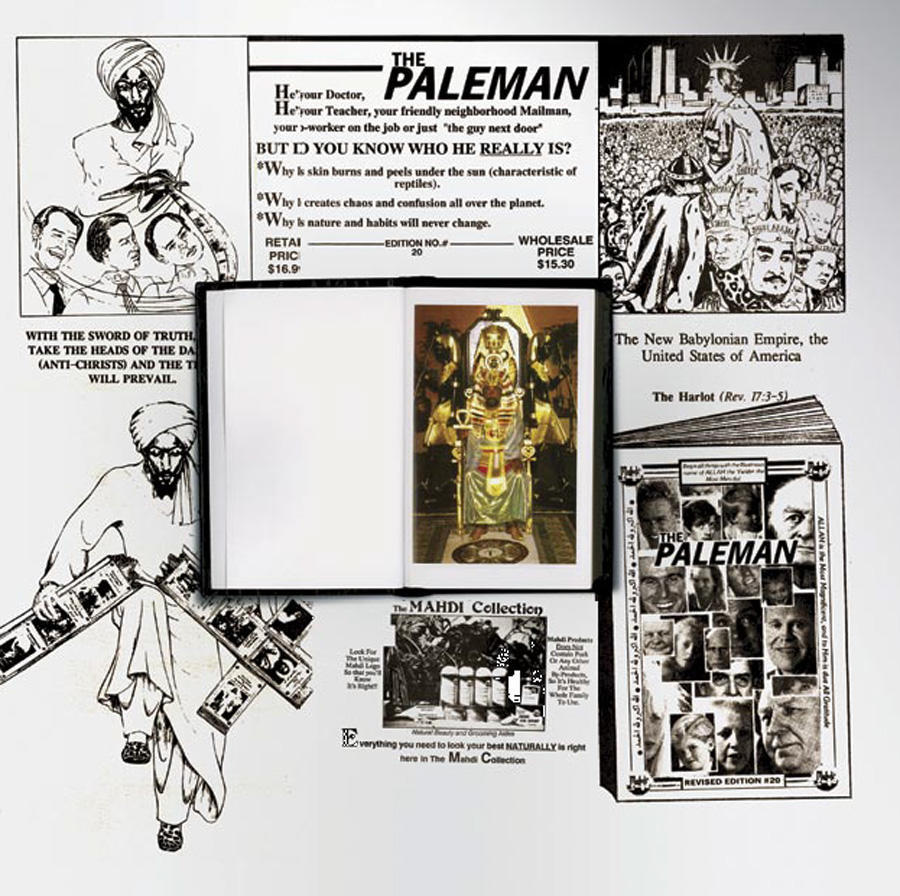
Back at the fin de siècle, I, like many New Yorkers, noticed the group now known as Nuwaubians: young black men in white turbans and djellabas selling bizarre looking pamphlets on street corners and in the subway. They were an aesthetically interesting phenomenon, but they never wore the right shoes. Instead of Islamic-style laceless slippers, they wore sneakers. So many American cultists seem to falter at the point where their feet touch the ground — a highly symbolic nexus. The exotic beauty that transformed the bodies and heads of these young men missed their feet.
As a devotee of Noble Drew Ali and the Moorish tradition in America, I appreciated some of the hundreds of pamphlets produced by Dr Malachi York (aka the Mahdi, aka Rabboni Y’Shua ben al-Haadi, aka Malchizadok York-El) for their highly original treatment of the material. Rumor had it that his writings roused the dangerous ire of the Farrakhan-led branch of the Nation of Islam. Whatever the truth of this, at a certain point York’s young pamphleteers vanished from our streets. After a few years, we learned from the newspapers that Dr York had undergone yet another religious transformation and become an ancient Egyptian deity, A’aferti Atum-Re. Deep in the rural South, he and his followers built a vast complex of pyramids and sphinxes, not very solid, but quite lovely.
In the end, fraud, racketeering, and child abuse brought down the sect and landed the deity in prison; he is due for release on December 15, 2119. The pyramids have been bulldozed. Still, the failures of sects and cults don’t necessarily invalidate their teachings — otherwise all religions would be in deep trouble. (As, indeed, they are.) Even madmen may be illuminated. Mystical experience and esoteric knowledge need not comport with ethics or even sanity.
There exists among the Moorish Americans and the Black Muslims and the Rastafarians a weaving together of esoteric strands called “the Knowledge,” compounded of numerology and gematria, myth, Afrocentric history, African-American paganism and HooDoo, freemasonry, Sufism, and dozens of other elements. It circulates at the level of oral transmission, video, and samizdat. Academic scholarship has paid almost no attention to this tradition. Like freemasonry, it is a subject that official historians rarely deign to touch.
Racism, of course, plays a role in scholarly neglect of the Knowledge, but the prejudice goes even deeper, down to a layer of bedrock consensus rationalism that results in actual blindness to certain forms of mysticism and art. Moreover, the Knowledge can’t be limited to African-American influences. Asian, American-Indian, and EuroAmerican strands are present in the weave. Noble Drew Ali identified the latter threads as Celtic in origin. The whole phenomenon actually escapes the categories of race so central to American consciousness, making it even more invisible to the famous gaze of instrumental reason.

In his Vision, William Butler Yeats said that the spirits told him they’d come to bring him new metaphors for his poetry. I admit that my aesthetic appreciation of the Nuwaubians, and of the whole of the Moorish tradition, guides my approach to the photographs collected here. But poetry demands actual participation in the forms it explores, and since 1964, I’ve been a member of the Moorish Orthodox Church of America, a “Celtic” offshoot of the Moorish Science Temple and a wandering bishop in the tradition of Apostolic Christianity. I guess you might call us distant spiritual cousins of the Nuwaubians. Their bible, The Sacred Records of Neter: Aaferti Atum Re Amunnubi Ruakhptah for the Secret Order of Wa-Set Lodge #1-19, presents a cosmology reminiscent of esoteric Scientology, complete with pyramids on Mars, divine invasions, crop circles, pyramids, Biblical exegesis, sexology, Sumerians from outer space, and other interesting tropes. It’s bound in black imitation crocodile skin with gold hieroglyphic cartouches, gilt-edged pages, and a yellow ribbon.
As literal dogma, this bible fails to move me, but if I think of it as poetry, I’d rank it far higher than “El” Ron Hubbard’s sorry SciFi Crowleyite melange. These photographs of Dr York in his many religious incarnations constitute a visual poem in which a kind of subjective revelation unfolds.